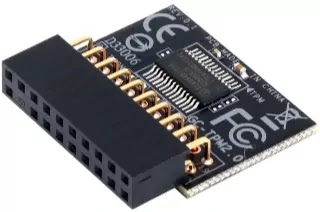What is a TPM Header?
TPM or Trusted Platform Module is a security electronic chip that sometimes comes prebuilt on the Motherboard of your computer. TPM Header is a cryptographic processor that offers security to the computer.
It was developed by Trusted Computing Group(AMD, HP, INTEL, MICROSOFT, and IBM) and standardized by IEC(International ElectroTechnical Commission) and ISO(International Organization for Standardization) as ISO/IEC 11889 in the year 2009. TPM uses RSA, SHA1, and HMAC cryptographic algorithms.
What does TPM Header Do?
TPM Header stores all the precious authentication data like Passwords, Certificates, Encryption Keys, etc. It uses a mix of software and hardware for device identification, authentication, encryption, and device integrity verification. Apart from this TPM Header also serves the following purposes:
1. Password Protection: Apart from storing the passwords, it also provides password protection to the device. Software-based password protection is more prone to Dictionary attacks(like Bruteforce), but since TPM is a Hardware module so it provides better protection from attacks while allowing a sufficient number of password tries to the user.
2. Disc Encryption: If somebody steals your storage disc and runs it on a different machine to steal your data then due to the mismatch of system configuration TPM will automatically encrypt the Disc whose cryptographic key (which can be created with encryption software such as Windows BitLocker) will only be available with the TPM module of the machine from where it is Stolen. Access to the data will be denied if the system configuration mismatches.
3. Platform Integrity: It ensures that malicious or inadvertent changes have not occurred on the system while booting.
4. It also helps in maintaining digital rights.
5. It ensures the protection of Software licenses.
6. It also ensures Theft Protection.
Does your Computer have TPM Header?
Since 2015, it has been made mandatory for all device manufacturers to install TPM 2.0 in their devices. You can check if your Computer has TPM Header Security Feature or not by following the steps given below:1
- Open the start menu.
- Search for Device Manager.
- In Device Manager Check under the Security Devices option if Trusted Platform Module appears or not.
- If TPM is available then press (Windows + R) or go running from the start menu.
- Then type tpm.msc in the blank space provided and click on ok.
- Under the TPM management console check for the Status and if it is active then it is perfectly working on your computer.
If your pc has TPM Module installed but isn't showing up under the Device Manager or the status of TPM is not active under the TPM Management console then you need to turn it on from the BIOS settings.
If your motherboard doesn't have a TPM Header Module built into it then you can add it by buying one. You just need to connect the TPM Header module to the port with the help of a wire.
NOTE: Smartphones and other network equipment also come with a TPM feature to ensure more security.







0 Comments
Please Do not Spam